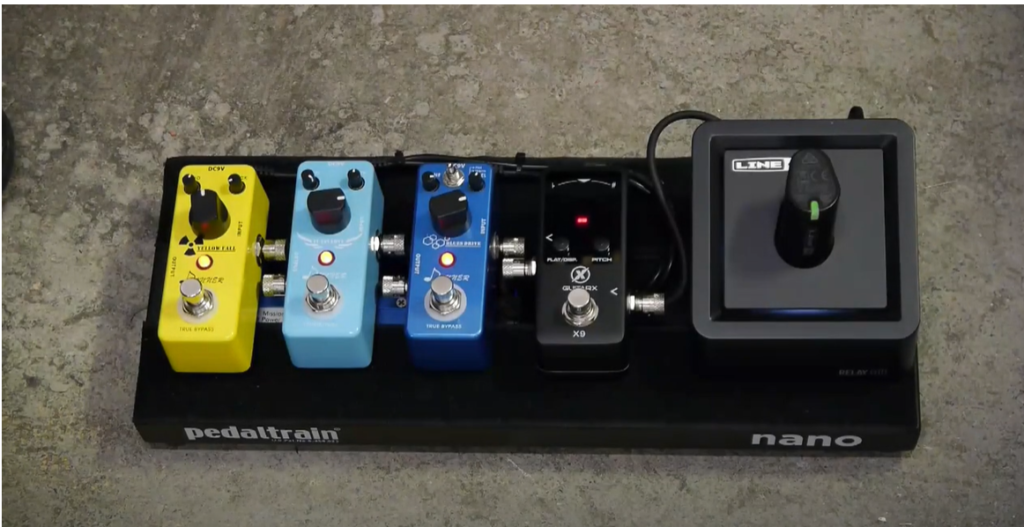Wireless pedalboards have revolutionized the music industry, allowing musicians to perform without the need for cables and wires. These pedalboards are essentially a collection of guitar pedals that are wirelessly connected to each other, eliminating the need for messy cables and making it easier for musicians to move around on stage.
Benefits of Wireless Pedalboards
The most significant benefit of wireless pedalboards is their ease of use. Musicians no longer need to worry about tripping over cables or getting tangled up in them while on stage. This makes it easier for them to move around freely and perform without any distractions.
Wireless pedalboards also eliminate the need for long cables, which can cause signal loss and degrade the sound quality. With a wireless pedalboard, the signal is transmitted digitally, ensuring that the sound quality is maintained at all times.
Another benefit of wireless pedalboards is their versatility. Musicians can easily switch between different pedals and effects without the need for complex rewiring. This makes it easier for them to experiment with different sounds and create unique sounds for their music.
How Wireless Pedalboards Work
Wireless pedalboards work by transmitting a digital signal from the guitar to the pedals, and then back to the amplifier. The wireless signal is transmitted using a radio frequency, which allows for a clear and reliable connection between the pedals.
The wireless signal is transmitted using a transmitter and receiver. The transmitter is connected to the guitar, while the receiver is connected to the pedals. The receiver then sends the signal to the amplifier, which produces the sound.
The transmitter and receiver are typically powered by batteries, which need to be recharged or replaced periodically. Some wireless pedalboards also come with a power supply, which can power the pedals and the wireless transmitter.
Types of Wireless Pedalboards
There are two main types of wireless pedalboards: standalone and modular.
Standalone wireless pedalboards are self-contained units that have all the necessary components built into them. These pedalboards are ideal for musicians who want a simple and easy-to-use setup. Standalone pedalboards typically come with a transmitter, receiver, and power supply built into a single unit.
Modular wireless pedalboards, on the other hand, allow musicians to build their own custom setups using individual pedals and wireless transmitters. These pedalboards are ideal for musicians who want more flexibility and control over their sound. Modular pedalboards typically require more setup time and can be more complex to use, but they offer more customization options.
Wireless pedalboards have become an essential tool for many musicians, allowing them to perform without the need for cables and wires. These pedalboards offer many benefits, including ease of use, improved sound quality, and greater versatility.
Overall, wireless pedalboards are an excellent investment for any musician looking to improve their live performances and streamline their setup. Whether you choose a standalone or modular pedalboard, the benefits of going wireless are clear, and the sound quality is sure to impress.
How to Make a Wireless Pedalboard?
Making a wireless pedalboard can be a rewarding project for any musician looking to improve their live performances and streamline their setup. While it may require some technical know-how and some trial and error, the end result can be a powerful and versatile tool for any musician. Here are the basic steps to make a wireless pedalboard:
Gather the necessary components: To make a wireless pedalboard, you will need a guitar, pedals, a wireless transmitter, a wireless receiver, a power supply, and cables. You may also need some tools, such as wire cutters, pliers, and a soldering iron.
Choose the right wireless system: There are many different wireless systems available on the market, each with their own strengths and weaknesses. Look for a system that has a clear and reliable signal, minimal latency, and a long battery life. You may also want to choose a system that allows for multiple channels, so you can switch between different guitars or effects.
Choose the right power supply: Wireless systems require power, so you will need to choose the right power supply to keep everything running smoothly. Look for a power supply that can provide enough voltage and amperage for all of your pedals and the wireless transmitter. You may also want to choose a power supply that has multiple outputs, so you can power multiple pedals at once.
Mount the pedals on a board: Once you have all of the components, you will need to mount the pedals on a board. Choose a board that is the right size for your pedals and has enough room for the wireless transmitter and power supply. You can use velcro or zip ties to secure the pedals to the board.
Connect the pedals: Once the pedals are mounted on the board, you will need to connect them using cables. Connect the input of the first pedal to the output of the guitar, and then connect the output of the last pedal to the input of the wireless transmitter. You may also need to connect additional cables to power the pedals and the wireless transmitter.
Connect the wireless receiver: Connect the wireless receiver to the amplifier using a cable. You may also need to connect the wireless receiver to a power supply.
Test the system: Once everything is connected, turn on the wireless system and test it out. Make sure the signal is clear and the sound quality is good. You may need to adjust the settings on the wireless transmitter and receiver to get the best sound.
Making a wireless pedalboard can be a fun and rewarding project, but it does require some technical know-how and patience. If you are not comfortable with wiring or soldering, it may be best to seek help from a professional or purchase a pre-made wireless pedalboard. With the right setup, you can enjoy the freedom and versatility of going wireless on stage.


